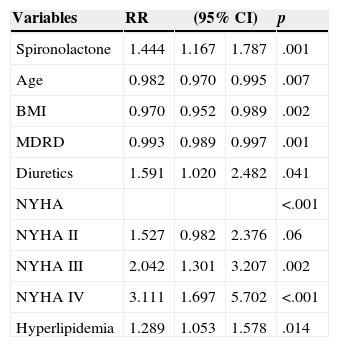Aldosterone inhibitors have been shown to be beneficial for patients with systolic heart failure. However, the evidence from patients with heart failure and preserved ejection fraction (HFPEF) is limited. We evaluated the role of spironolactone in the prognosis of a cohort of patients with HFPEF.
Patients and methodsWe analyzed the outcomes of patients hospitalized for HFPEF in 52 departments of internal medicine of the Spanish RICA registry according to those who did and did not take spironolactone. We recorded the posthospital mortality rate and readmissions at 1 year and performed a multivariate survival analysis.
ResultsWe included 1212 patients with HFPEF, with a mean age of 79 years (standard deviation, 7.9), (64.1% women), the majority of whom had hypertensive heart disease (50.7%). The patients treated with spironolactone, compared with those who were not treated with this diuretic, had a more advanced functional class, a higher number of readmissions (44.3 vs. 29.1%; p<0.001) and a higher rate in the combined variable of readmissions/mortality (39.0 vs. 29.0%; p=0.001). In the multivariate analysis, the administration of spironolactone was associated with an increase in readmissions (RR, 1.4; 95% CI, 1.16–1.78; p=0.001).
ConclusionsFor patients with HFPEF, the administration of spironolactone was associated with an increase in all-cause readmission, perhaps due to the higher rate of hyperpotassemia.
Los inhibidores de la aldosterona han demostrado ser beneficiosos en pacientes con insuficiencia cardiaca sistólica. Sin embargo, la evidencia en enfermos con insuficiencia cardiaca y fracción de eyección preservada (ICFEP) es muy limitada. Hemos evaluado el protagonismo de la espironolactona en el pronóstico de una cohorte de pacientes con ICFEP.
Pacientes y métodosAnalizamos la evolución de los pacientes ingresados por ICFEP en 52 servicios de Medicina Interna del Registro español RICA según la toma o no de espironolactona. Se recogió la tasa de mortalidad poshospitalaria y reingresos a un año, y se realizó un análisis de supervivencia multivariante.
ResultadosSe incluyeron 1212 pacientes con ICFEP con una edad media de 79 años (desviación estándar 7,9), (64,1% mujeres), la mayoría con cardiopatía hipertensiva (50,7%). Los pacientes tratados con espironolactona, en comparación con los que no recibieron este diurético, presentaron una clase funcional más avanzada, mayor número de reingresos (44,3 vs. 29,1%; p<0,001), y mayor tasa en la variable combinada de reingresos/mortalidad (39,0 vs. 29,0%; p=0,001). En el análisis multivariante, la administración de espironolactona se asoció a un aumento de los reingresos (RR 1,4; IC95%, 1,16-1,78; p=0,001).
ConclusionesEn pacientes con ICFEP, la administración de espironolactona se asoció a un incremento de los reingresos por cualquier causa, tal vez en relación con la mayor tasa de hiperpotasemia.
Article
Diríjase desde aquí a la web de la >>>FESEMI<<< e inicie sesión mediante el formulario que se encuentra en la barra superior, pulsando sobre el candado.

Una vez autentificado, en la misma web de FESEMI, en el menú superior, elija la opción deseada.

>>>FESEMI<<<










